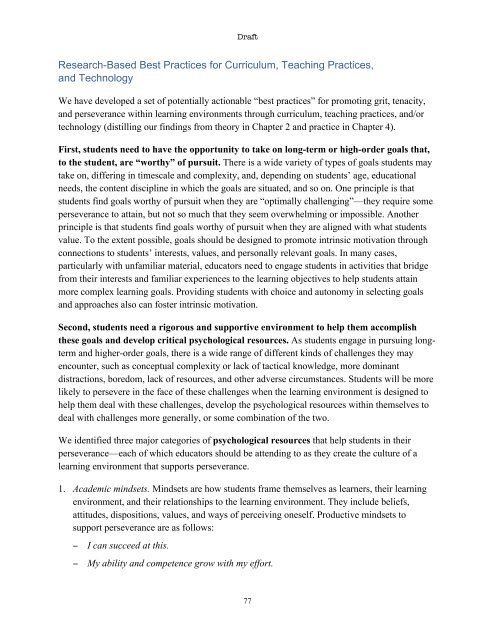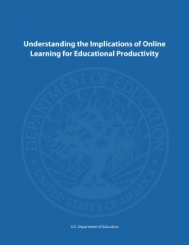Promoting Grit, Tenacity, and Perseverance - U.S. Department of ...
Promoting Grit, Tenacity, and Perseverance - U.S. Department of ...
Promoting Grit, Tenacity, and Perseverance - U.S. Department of ...
You also want an ePaper? Increase the reach of your titles
YUMPU automatically turns print PDFs into web optimized ePapers that Google loves.
Draft<br />
Research-Based Best Practices for Curriculum, Teaching Practices,<br />
<strong>and</strong> Technology<br />
We have developed a set <strong>of</strong> potentially actionable “best practices” for promoting grit, tenacity,<br />
<strong>and</strong> perseverance within learning environments through curriculum, teaching practices, <strong>and</strong>/or<br />
technology (distilling our findings from theory in Chapter 2 <strong>and</strong> practice in Chapter 4).<br />
First, students need to have the opportunity to take on long-term or high-order goals that,<br />
to the student, are “worthy” <strong>of</strong> pursuit. There is a wide variety <strong>of</strong> types <strong>of</strong> goals students may<br />
take on, differing in timescale <strong>and</strong> complexity, <strong>and</strong>, depending on students’ age, educational<br />
needs, the content discipline in which the goals are situated, <strong>and</strong> so on. One principle is that<br />
students find goals worthy <strong>of</strong> pursuit when they are “optimally challenging”—they require some<br />
perseverance to attain, but not so much that they seem overwhelming or impossible. Another<br />
principle is that students find goals worthy <strong>of</strong> pursuit when they are aligned with what students<br />
value. To the extent possible, goals should be designed to promote intrinsic motivation through<br />
connections to students’ interests, values, <strong>and</strong> personally relevant goals. In many cases,<br />
particularly with unfamiliar material, educators need to engage students in activities that bridge<br />
from their interests <strong>and</strong> familiar experiences to the learning objectives to help students attain<br />
more complex learning goals. Providing students with choice <strong>and</strong> autonomy in selecting goals<br />
<strong>and</strong> approaches also can foster intrinsic motivation.<br />
Second, students need a rigorous <strong>and</strong> supportive environment to help them accomplish<br />
these goals <strong>and</strong> develop critical psychological resources. As students engage in pursuing longterm<br />
<strong>and</strong> higher-order goals, there is a wide range <strong>of</strong> different kinds <strong>of</strong> challenges they may<br />
encounter, such as conceptual complexity or lack <strong>of</strong> tactical knowledge, more dominant<br />
distractions, boredom, lack <strong>of</strong> resources, <strong>and</strong> other adverse circumstances. Students will be more<br />
likely to persevere in the face <strong>of</strong> these challenges when the learning environment is designed to<br />
help them deal with these challenges, develop the psychological resources within themselves to<br />
deal with challenges more generally, or some combination <strong>of</strong> the two.<br />
We identified three major categories <strong>of</strong> psychological resources that help students in their<br />
perseverance—each <strong>of</strong> which educators should be attending to as they create the culture <strong>of</strong> a<br />
learning environment that supports perseverance.<br />
1. Academic mindsets. Mindsets are how students frame themselves as learners, their learning<br />
environment, <strong>and</strong> their relationships to the learning environment. They include beliefs,<br />
attitudes, dispositions, values, <strong>and</strong> ways <strong>of</strong> perceiving oneself. Productive mindsets to<br />
support perseverance are as follows:<br />
− I can succeed at this.<br />
− My ability <strong>and</strong> competence grow with my effort.<br />
77
















